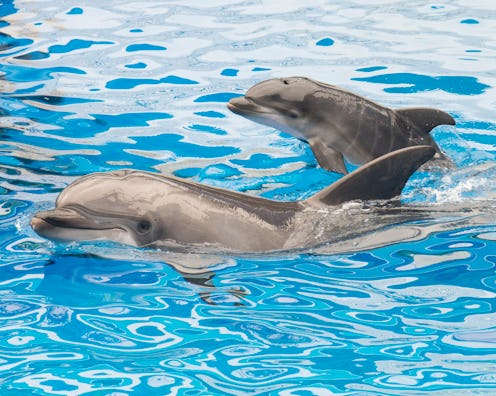
In 1965, scientist John C. Lilly embarked upon an experiment the likes of which had never been attempted before. It involved having a human woman live, day and night, with a bottlenose dolphin, studying how they communicated and even trying to teach the dolphin to speak English. The dolphin’s name was Peter; the woman’s, Margaret Howe, a then-23-year-old native of the Virgin Islands, where the experiment took place. During the course of the experiment, however, something no one predicted happened: Peter fell in love with Howe — romantically and sexually.
Yes, you read that right.
According to the Telegraph, Howe is the subject of an upcoming documentary scheduled to air on the BBC later this month. Entitled The Girl Who Talked to Dolphins, it marks the first time in nearly 50 years Howe has spoken of the experiment; after decades of silence, she accepted an interview earlier this year by BBC producer Mark Hedgecoe, who called it “the most remarkable story of animal science I had ever heard.”
For six weeks, Howe lived in almost total isolation with Peter in a villa that had been flooded with 22 inches of seawater. The water was deep enough for Peter to swim in, but shallow enough for Howe to wade in; a desk suspended from the ceiling allowed her to work and write in her journal out of the water, and a hanging mattress protected by a shower curtain gave her a dry place to sleep. She ate canned food, negating the need for deliveries; she and Peter followed a regular daily routine, untouched by the outside world. English lessons began at 8am; 10am was play time; and more lessons occurred at 12pm and 3pm, with feeding sessions and more play time in between. Peter apparently liked to watch TV as much as he enjoyed playing fetch with balls and towels. This clip from the documentary shows what a typical English lesson with Peter was like:
Over time, Peter developed genuine affection for Howe; this is unsurprising, given what we know about both dolphins’ intelligence and their social behavior. During the fifth week, though, Howe reported in her diary, “Peter begins having erections and has them frequently when I play with him.” She became scared as his “sexual needs” and advances grew more aggressive, noting that dolphin could easily “bite [her] in two” — but she ended up taking matters into her own hands. Literally. As the narrator apparently says in The Girl Who Talked to Dolphins, “Margaret felt that the best way of focusing [Peter’s] mind back on his lessons was to relieve his desires herself manually.” I’m not totally clear what that means, but I assume it was something akin to a dolphin hand job. Ethical? Uh... not so much.
We know that dolphins are one of the only other animals besides humans who have sex for pleasure (the other being bonobos); we also know, said dolphin ethics specialist Professor Thomas White to the Telegraph, that sex among dolphins is “a normal way to establish a bond.” He elaborated, “Dolphins are mostly bisexual sometimes heterosexual, sometimes homosexual, and quite frequent—eight to 10 times a day I’ve been told — so it’s a very different culture that we’re looking at.” As such, Peter’s advances toward Howe weren’t that surprising. But the depth of the relationship between Peter and Howe took all sorts of unexpected turns, with Peter becoming gentle and essentially wooing his human companion. Howe referred to it in her journal as “courting” behavior, and today noted, “It was very precious. It was very gentle… It was sexual on his part. It was not sexual on mine. Sensual, perhaps.”
Ultimately the experiment failed; funding was pulled after six weeks instead of the intended 10, and it’s been noted time and time again since then that it was pretty unethical in the first place. It’s true that sex with animals isn’t illegal everywhere — it’s only against the law in 37 states in the U.S., and it’s perfectly legal in a few countries like Denmark — but I think Mental Floss was right to include it in a roundup of four bizarre experiments that should never, ever be repeated. (Fun fact: There exists a Wikipedia page entitled “Zoophilia and the Law.” True story). The really awful thing, though? Howe ended up marrying the photographer assigned to the project, John Lovatt — but Peter, according to the Daily Mail, deteriorated rapidly after being moved from the Virgin Islands to Lilly’s other lab in Miami, Florida. After a few weeks, Howe learned that the dolphin had committed suicide by refusing to breathe and sinking to the bottom of his tank. That’s how distraught he was at being separated from Howe.
Unbelievably sad.
The Girl Who Talked to Dolphins will premiere at the Sheffield Doc/Fest in the UK on June 11 and on BBC4 on June 18. No word on whether it’s set to air in the U.S. yet, but I’m sure if you’re a tech-savvy individual, you’ll probably be able to figure out a way to watch it. If anyone manages to get a hold of it, let us know how it is, OK? Inquiring minds want to know!